Text
☆ヾ(・ェ・。`U
Despite being a PE and Health major, the self who loves reading any books and watching any series still excites at any literature subject available.
Contemporary Literature is one of the few that I had to take in my undergraduate program. It reminded me of my 17-year-old self who aspired to be a literature student. I was heavily inspired by my former class advisers in Grade 7 and Grade 12 who took the same bachelor degree in PNU.
Unfortunately, I couldn’t make it because of the changes in the major list. Even then, I still indulge myself in these nerdy and boring as I still love the world of inks and production films.
Here is a collection of my class participation and class activities.
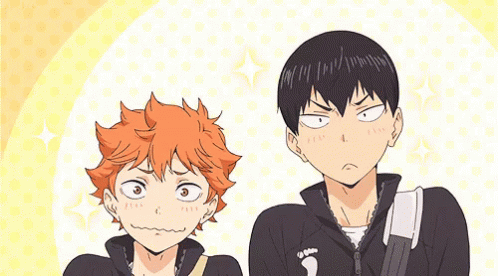
Links:
Class Recits - 01, 02, 03
Lit Huddles
Other Activity
Genre Analysis: Introduction
Genre Analysis: The Literary Text in Focus
Genre Analysis: The Genre Analysis
Genre Analysis: Something Personal
Reflection
0 notes
Text
Class Recit #01 - The Postmodernism Conflict
I only speak my mind in every class.
This reminded me of the class I had in Grade 12 (forgot the subject (ノ‥)ノ). It was nostalgic. I felt nostalgia.
0 notes
Text
Class Recit #02 - Pastiche and Parody
I was actually thinking of Detective Conan in the honor of Sherlock Holmes for Pastiche
and
Epic Movie for Parody, a collection of references from: The Chronicles of Narnia: The Lion, the Witch and the Wardrobe, Harry Potter, Charlie and the Chocolate Factory, Pirates of the Carribean, and X-Men: The Last Stand.
0 notes
Text
LIT HUDDLES
Being grouped with these people was making me nervous. I may have once worked with them in the previous groupings in the other subjects and it was okay. But with the current situation that everyone is still restricted in their movements (home and country rules), this proved to be difficult to handle. Especially with my enthusiasm in the subject, I was wondering if they could keep up with me. Thus, my doubt.
But, I placed my trust in these people that I am grateful for their cooperation, as the de facto leader of this group ( ̄ー ̄;, that we were able to finish the task successfully and smoothly.
01. WHITE COMEDY

- me tryin’ to make them work in any way I could think of (* ̄∀ ̄)

- (〃∇〃) hehe

They’ve done really well. I was so proud. (๑˃̵ᴗ˂̵)و
The video was uploaded in the Facebook group: CLICK ME
02. THE DEVIL WEARS PRADA
I volunteered as the prompter for the purpose that I am breaking down the movie based on the question assigned to our group. My fascination with analyzing literary works was taking over.
And they let me do it.
YEY (ฅ⁍̴̀◊⁍̴́)و ̑̑

I got excited (๑•̀ㅂ•́)✧
The actual post was also in the Facebook group ✧
03. LIKE WATER FOR CHOCOLATE
Once again, I was the prompter for this huddle.


and TADAAA (☆□☆)
the final work has been uploaded in the drive: CLICK ME TOO

Yay, huddles done!
0 notes
Text
Other activity
The mind map I did as the first class activity.

0 notes
Text
Genre Analysis
Introduction
I consider myself as a Japanophile (someone who loves and admires Japan, often to the point of favoring Japan or Japanese over another nation or culture and sometimes beyond the point of rationality.) rather than a weeaboo or "weeb". To me who is in her early 20's, manga and anime are a part of life. It is breakfast, lunch, afternoon snack, dinner, and midnight snack. It gave me a door to defining my identity. That is why it is important for me to be well-versed in how manga and anime play an important part in Japanese contemporary art and literature.
Modern manga took shape in the post-war decades. It has been historically and culturally influenced by the western countries and the events that followed after World War II. This led to a figurative outburst of artistic creativity in Japanese post-war society. Two of the famous ground-breaking works are Osamu Tezuka's Astro Boy in 1951, heralding the man as the "Godfather of Manga", and Hasegawa Machiko's Sazae-san in 1946, as the "Godmother of Manga".

Astro Boy plays the antithesis role to the formerly propagated idealistic Japanese society during the years of imperialism. His kindness brought a new age of pacifism that was hugely popular with a society that was scarred both by the war itself and the imperialism propaganda that came with it. By contrast, Sazae-san is a strong character, a striking contrast to the officially sanctioned Neo-Confucianist principles of feminine meekness and obedience to the "good wife, wise mother" ideal taught by the previous military regime. Her cheerful resilience as she faced the world became what the Japanese call a "woman of endurance".
Since then, Manga wasn't depicted as a message. It became a form of medium in democratic ways that reflects the society from more angles than one. Like the western comics, it is a different kind of storytelling that uses visual style. That is why it catches the eyes of many. As it is originally inspired by the western, other manga writers and illustrators began to experiment before coming up with their own artistic style. And because Astro Boy became popular with the western audiences and Sazae-san to the whole of Japan, the two became highly influential in the anime industry that was starting to rise at that time.

Dragon Ball's Son Goku was said to play the father role of the three. One Piece's Luffy (left), Bleach's Ichigo (middle), and Naruto (right).
I spent a huge portion of my life with Naruto, which caused a comedic rift in our family. My father and sister prefer One Piece while my mother likes Yamato Nadeshiko: Shichi Henge. We used to banter a lot about which series was better and I feel sorry for Ichigo being left out. I haven't watched One Piece as a whole but I watched an arc while I've only got to watch Bleach's Live-Action Film thanks to Netflix.
It was followed by a large number of mangas and anime we can call classics today. It was in 1986 when Akira Toriyama's Dragon Ball (1984) was broadcasted in Japan that introduced the martial arts genre. It also became another highly influential work in the Japanese industry. It influenced Oda Eiichiro's One Piece (1997), Masashi Kishimoto's Naruto (1999), and Tite Kubo's Bleach (2001). Later on, the three aforementioned manga (that turned to anime), dominated the front pages of Shonen Jump Weekly and took over Japan. Despite the fact that Naruto and Bleach have ended and One Piece is still running, their popularity never fades and has been used as a reference in the new works, even has cameos in the manga and anime that followed them years later. To this day, they are called The Big Three, clubbed together for their popularity in their era, having similarities in each protagonist (either bearing resemblance from Goku's color scheme or his personality), and the length of the series, which has influenced the rest of the manga (and anime) industry. This includes:
Manga store
Manga cafes
Annual manga exhibition
Manga magazines
Doujinshi - is very much like fan fiction (a world I've been living in particularly as a fan of anime and manga. I'm found in Archive of Our Own and Fanfiction.net). It is a parody that includes characters from popular manga and anime series.
International market - Having manga publishing companies all over the world
Awards sponsored by manga publishers including The Tezuka Award for Best New Serial manga
Digital manga - there are two main ways in which mangaka's work could be published: taking their manga drawn on paper to a publisher themselves or submitting their works to competitions run by magazines. But nowadays, most of the mangakas (amateur and professional) post their works online (Pixiv and Twitter) where they gain popularity on the internet before being contacted by a publishing company. An example is ONE's One Punch Man, a form of Web Manga that was released online and later on received a professional remake and an anime adaptation. Another is Webtoon (my sister's kind of world as she's an artist posting her webtoon there. She has not shared her pen name with me and neither I), a new medium of comics in Asia where manga are released using this form. It has brought a new age to the manga by having all titles in color and some with special animations and effects. An example is Yayoiso's ReLife.

4 notes
·
View notes
Text
Genre Analysis
The Literary Text in Focus
Out of all the manga I've read, a sports manga called Haikyū!! is one of my favorite rereads. It is written and illustrated by Haruichi Furudate in 2012 and last July 20, 2020, the series has reached its last chapter.
Furudate's favorite series are One Piece by Oda Eiichiro and Tekkonkinkreet by Matsumoto Taiyō and has always looked up to and yearned to match Kubo Tite's (the mangaka of "Bleach") visual style. Haikyuu!! was inspired by his feelings of frustration and regret, being a part of the volleyball club in his middle and high school due to his strong sense of attachment to the sport, Furudate revealed in an interview with Monthly Volleyball 2014-March Issue.
It follows the story of Hinata Shōyō, after seeing a volleyball match, aims to become the next "Little Giant" and thus joins his middle school volleyball club. After finding new members, he sets out for the middle school tournament, where he crosses paths with a formidable school with the "King of the Court," Kageyama Tobio. Although his team lost, Hinata is still determined to aim for the top and exact revenge on Kageyama. Upon entering high school, he receives the biggest surprise: He and Kageyama are in the same high school volleyball club!
Haikyuu!! means "volleyball". The katakana used in the title ハイキュー!! (ba-re-bo-ru) came from the kanji 排球 bearing the same meaning.
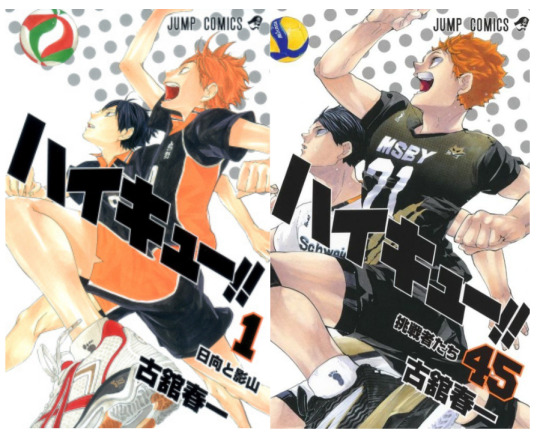
The story is set in a fictional town called Torono in Miyagi Prefecture. However, the school used (Karasuno High School - Karumai High School) and most of the locations (Sakanoshita Shop - Kaneda Store, Sendai Arena Gymnasium (now called Kamei Arena Sendai), the Kuroo and Kenma River - Yukiyagawa Riverbed Park ), Shiratorizawa Academy (Tohoku High School) are based in real life. Most of them are found in the mangaka's hometown, Iwate Prefecture, just farther north of Miyagi while the others (Tokyo Metropolitan Gymnasium) are in Tokyo.

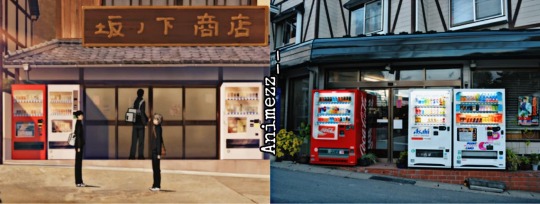



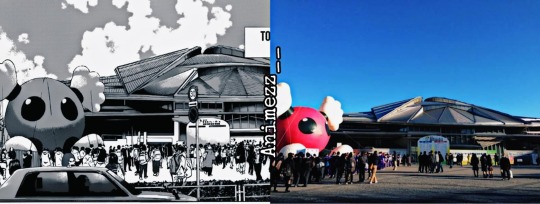
Characters:

Karasuno High School Volleyball Team
#1 - Sawamura Daichi - 3rd Year/Wing-Spiker/Captain
#2 - Sugawara Koushi - 3rd Year/Setter/Vice-Captain
#3 - Azumane Asahi - 3rd Year/Wing-Spiker/Ace
#4 - Nishinoya Yuu - 2nd Year/Libero
#5 - Tanaka Ryuunosuke - 2nd Year/Wing-Spiker
#6 - Ennoshita Chikara - 2nd Year/Wing-Spiker
#7 - Kinoshita Hisashi - 2nd Year/Middle Blocker/Pinch Server
#8 - Narita Kazuhito - 2nd Year/Middle Blocker
#9 - Kageyama Tobio - 1st Year/Setter/Deuteragonist
#10 - Hinata Shouyo - 1st Year/Middle Blocker/Protagonist
#11 - Tsukishima Kei - 1st Year/Middle Blocker
#12 - Yamaguchi Tadashi - 1st Year/Middle Blocker/Pinch Server
Others:
Shimizu Kiyoko - 3rd Year/Head Manager
Yachi Hitoka - 1st Year/Assistant Manager
Takeda Ittetsu - Literature Teacher/Head Coach
Ukai Keishin - Sakanoshita Clerk/Assistant Coach
Ukai Ikkei - Retired/Former Head Coach

The story is written in the third person point of view. Readers could read the thoughts of any characters seen in any panel which allows us to see through what kind of character they are with their own speech bubbles.
Naturally and like any other sports manga and anime, the story follows where the main protagonist (Hinata) and his team aim to achieve their dream of going to the Nationals or rank first in the competition (and the world for Kageyama). It tells us about teamwork and friendship, also including:
Connect - Volleyball is played by passing the ball without touching it for longer than a second. Whoever lets the ball fall in the ground, loses. That's why it is important for any team to let the ball in play and connect each game in order to win.
The characters of Haikyuu!! are all connected in some ways. Through volleyball, each of them gets to know one another. They became teammates and colleagues in the future (professional leagues for most), all because they played volleyball in high school. The plays they made back then have made a connection to which these characters can relate and look back as players. Them who once played against each other and played together and the court will never forget their defeats and victories.
This is used as a banner in another school located in Tokyo, Nekoma High School, the rival of Karasuno High School.
Using defeat as strength - The head coach, Takeda-sensei once asked Hinata and Kageyama, "Isn't losing difficult for all of you? A challenge where ending up on your hands and knees, you must see if you can stand up again? If you stay on your hands and knees, that proves that you are weak." (To Hinata and Kageyama after Karasuno's Interhigh match against Aoba Johsai, Volume 8 Chapter 69).
In every challenge, may it be in life or in sport, victory is never guaranteed unless prepared. But even though, you are prepared, there is still no guarantee that you won't lose. The same man stated when Karasuno loses in the Nationals arc.
"Remember this feeling. There will surely be times in your life when you will feel this way again. There will come a time when there's nothing you can do. Whenever that happens, pay attention and etch it into your mind. You said you were going to win the gold medal someday. And not just one. And now, you know that there are walls that you can't overcome with reckless effort. When that time comes, what you need, is knowledge, logic, and thought. Hinata-kun, this moment, right now, is also volleyball. Think about how to win." (To Hinata, Volume 41 Chapter 365).
Connecting to the question in the same chapter: "Today you are defeated, which will you be tomorrow?"
How frustrating it was for the favorite team to lose the chance to emerge as victors but it didn't end in despair. It was a chance. A chance to grow and be better.
The limit does not exist - Pushing beyond your limits is not about overcoming them. Beyond the boundaries of what you can do entails the limit of your capabilities as a human but that doesn't stop there. The limit does not exist as long as you keep on raising the bar. Oikawa of Aoba Johsai and Hinata of Karasuno are two characters faced with limits. Hinata with his short physique and Oikawa with his fear of losing to Kageyama's genius setting.
But years later in the time-skip, Oikawa now plays in an Argentina National Volleyball Team and Hinata in Brazil's.
Fly - Volleyball is a sport where height is highly valued. The former Coach Ukai Ikkei once said: "Because people don't have wings, we look for ways to fly." (To Keishin, Volume 4 Chapter 30)
Besides, flying means being free. Hinata mentioned it once during the Nationals arc, "being good means being free" as freedom is usually associated with birds, flying, and wings.
Karasuno has the Kanji "crow" (烏 Karasu) in it’s name. Fly is the team's banner, pertaining to how these former champions became flightless in the absence of Coach Ukai Ikkei, should find ways to fight and fly again. They were able to achieve that since Hinata and Kageyama attended Karasuno and joined the volleyball team. It's that symbolic.
The other teams in Haikyuu!! uses animals. Shiratorizawa - Swan/Eagle, Fukurodani - Owls, Nekoma - Cats, Sarukawa - Monkeys, Nohebi - Snake, Kamomedai - Seagulls, Itachiyama - Weasels, Inarizaki - Fox, MSBY Black Jackals - Panthers, Schweiden Adlers - White Eagles.
Volleyball is fun - The stress of victory and defeat lurking at every end of the match might take away the essence of playing the sport altogether. But the series was never about who wins and who loses. It is simply about playing volleyball. They all have roots of why they played the sport in the first place and when things get hard, these characters always looked back and fight. The third-years wants to stand on the court and reclaim the name of being a former powerhouse school in volleyball. For Hinata, it was the Little Giant, whom he once aspired. For Oikawa, it's because he wants to be like the professional setter Jose Blanco. For Kageyama, he wants to play in the court for longer than anyone would want. All because they love it and it's fun.

Haikyuu!! characters gathering together in the last chapter of the manga. Not only does it include the teams that play but also the people supporting them in the background.
This series also has a stage play called Hyper Projection Play "Haikyū!!" first run in 2015 and the last play was in 2020, choosing to cancel the upcoming plays to the end of the series due to the coronavirus outbreak
youtube
This is a video from Youtube, a compilation of the emotional moment in the Haikyuu!! anime.
10 notes
·
View notes
Text
Genre Analysis
The Genre Analysis
What is Manga?
Manga is an umbrella term for a wide variety of comic books and graphic novels originally produced and published in Japan. Unlike American comic books, which are usually printed in full color, Japanese manga are almost always published in black and white. Full-color prints are often only used for special releases such as Illustration Book and Character Book Guide.
Japanese manga is read right to left rather than left to right, which is the norm for English language publications. It is typically released on a monthly or a weekly chapter-by-chapter basis through manga magazines such as Weekly Shōnen Jump, (which has been in circulation since 1968). If a series is popular enough, its chapters are then collected and published into volumes called tankōbon volumes, which usually feature a few chapters of the overall story normally 4 to 7 chapters utmost.
Most manga series are long-running and can span multiple volumes. Small series like Chihiro Harumi's Velvet Kiss, which only has 4 volumes is easy and can be finish reading in a day compared to Oda Eiichiro's One Piece, which currently has 98 volumes and still updating.
Five demographics of manga or manga target audience:
1. Shonen
Target: tween and teen boys
Common themes: Action, Adventure, Friendship, Coming of age,
Shonen manga often feature lots of action and comedy and some sort of coming-of-age camaraderie between characters. The manga magazine Weekly Shōnen Jump and its American counterpart, Shonen Jump, have routinely published some of the most popular shonen manga series of the last 30 years including Akira Toriyama's Dragon Ball, Hiromu Arakawa's Fullmetal Alchemist, Oda Eiichiro's One Piece, and Kohei Horikoshi's My Hero Academia. Covers for shonen series usually feature male protagonists in some sort of action pose.

2. Shōjo
Target: tween and teen girls
Common themes: Drama, Romance, Coming of age
Like Shonen manga, Shojo manga features the coming-of-age story of a young female protagonist. You can usually identify Shojo covers by their use of pretty pinks, flowers, or other cutesy images.
Karuho Shiina's Kimi ni Todoke is an example of a Shojo series. It has been adapted into anime and live-action film.
Because of the number of Shoujo manga rising to popularity and has been published with their own volumes, many of them turned to anime adaptations and live-action films. Yamazaki Kento, a Japanese actor has been hailed as the Prince of Live-Action Films, because of the notable roles he landed in the acting industry. Most of them are from Shoujo mangas being the male lead character and love interest of the protagonist.

3. Seinen
Target: Adult men (18+)
Common themes: Action, Violence, Sex, Adult themes
Just like Shonen manga, Seinen manga features action and violence, but with a more serious or darker tone, as well as adult content such as sexual situations, graphic violence, or foul language. Seinen series usually follow protagonists who must face a reality where the hero does not always save the day. Seinen covers are often dark and gritty and feature male protagonists.
Otomo Katsuhiro's Akira is one of the most recognizable seinen thanks in part to its epic anime adaptation and Miura Kentarō's Berserk has been in publication since its debut in 1989. Chica Umino's March Comes in Like a Lion is set in modern Japan telling a story of a 17-year old dealing with adult problems such as financial difficulties, loneliness, and depression.

4. Josei
Target: Adult women (18+)
Common themes: Drama, Romance, Sex, Slice of life
Josei manga often features more mature narratives exploring romantic and personal relationships, told in greater depth than their Shojo counterparts. It is similar to American adult romance novels in that they include sexually explicit scenes that can range from tame to borderline pornographic.
Unlike Shojo manga, which almost always follows a female protagonist, Josei manga often features male and female protagonists. Unlike Shonen, Shojo, or Seinen manga, Josei manga cannot always be quickly identified solely from its cover.
Fujita's Wotakoi: Love is Hard for Otaku is one of the most well-known Josei manga series because of the success of its anime adaptation and live-action.

5. Kodomomuke
Target: young children
These series will often be cutesy, moralistic, and fun to catch the attention of children. From the name itself, Kodomomuke, the word "Kodomo" (子供) means children or kids.
Both the Pokemon and Doraemon manga and anime are probably the most well-known examples of a Kodomomuke series. Powerpuff Girl Z and Digimon as well.
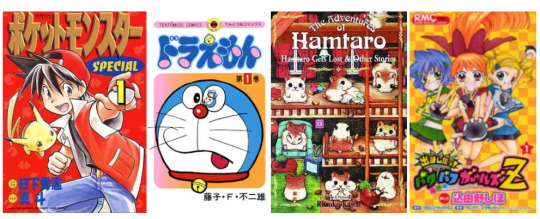
Despite the demographics suggested, it does not entirely mean that we should follow this. Watching anime and reading manga are based on each taste. I, for one, am an example of a young lady who prefers reading Shounen than Shoujo or Josei. There are cross-gender and age divides mangas as well where despite having a female protagonist, the series is under Shounen. The Promised Neverland for example. Even though a teen boy protagonist in March Comes in Like a Lion, the series was under the Seinen due to the adult content.
A few may ignore and reject manga as literature. Being commonly labeled as comics, graphic novels, and bore similarities to doodle fictions, the literary genres aforementioned also happens to be literary pieces. Manga is a written work as well as any other and is considered literature no matter what people say.
It's not entirely different from the comics. Both of them use visuals rather than beautiful, descriptive words to describe the experiences and emotions of a particular iconic scenario. It is a form of a unique style of storytelling.
But what makes Manga stand out is the element. Manga always pertains to the Japanese. This includes culture, people, environment, and behavior. The characteristics it always has will always differ from the rest by drawing characters with abnormal hair color, big eyes with abnormal color, sometimes out-of-proportion body parts, and small mouths.
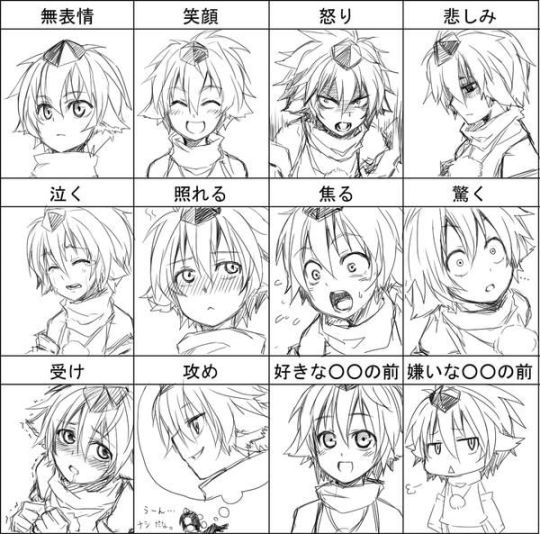
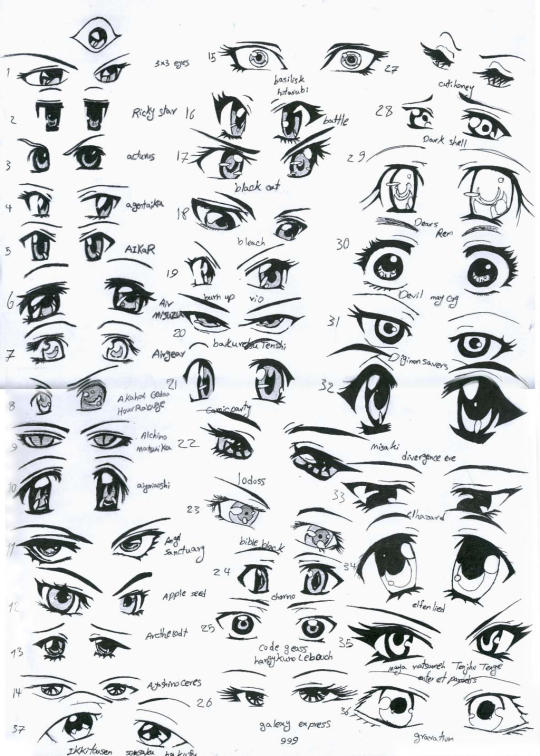
It uses conventional graphics to emphasize the moods. An example is the pastiche of flowery, sparkling background or dark vertical lines for the underlying meaning of the mood or situation.


I believe it's very Japanese and the country made themselves a brand because of this.
0 notes
Text
Genre Analysis
Something Personal
I started reading manga in Grade 8.
The first manga that I happened to read that time (unfortunately for my virgin eyes and not-so virgin mind) was Velvet Kiss.
[ I chose not to upload the cover of the first volume I overlooked before because it's not suitable for my academic requirement. And it's too revealing.]
Nitta Shin, a white-collar worker was suddenly confronted with an 80 million dollar debt bearing his signature. The agents however allow him to settle the debt if Nitta agrees to befriend a girl, Kanoko Kikuchiya.
I solemnly swear that the plot summary took my interest. (≖_≖ )
After that, the world of manga that showed me pushed me to read more in other genres this time, particularly Shoujo. I believe it is befitting for my type being a young lady. But as time passes by, I found myself getting attached to Horror and Shounen. The action-packed scenes and thrill gets my blood excited and pumped
( ⚆ _ ⚆ ).

Nakamura Shiharu is a young high school student who loves kids. She lives in an orphanage and works at daycare to earn money for future expenses. One day, the handsome uncle of two-year-old twins, Matsunaga Seiji, offers her a raise if she'll be their babysitter, and Shiharu accepts his offer.
Kouchi Kaede's Love So Life was not the first Shoujo I've read but it is one the best that I'll gladly read over again (Re-read count: 4) and currently, I am waiting for the last chapter in the sequel: Life So Happy, set seven years later.
[I BELIEVE IT'S SEIJI'S AND SHIHARU'S WEDDING NEXT SO I'M VERY EXCITED.
˭̡̞(◞⁎˃ᆺ˂)◞*✰]
This story of fluff about babysitting and slow-burn romance has caught my attention. The fuwaa-fuwaa aura it has on the volume cover alone was already bright and it made me see that most of the Shoujo mangas I've read have the same aura. And not only does it tells a story on how to handle toddlers abandoned by a grieving parent, but it also tackles what it means to become an adult, being unable to move on from the death of a loved one, and the importance of family.

[Photo in the lower left was taken with the reading mode in dim because it was night.]
This is my favorite horror, Oshimi Shūzō's Chi no Wadachi/Blood on Tracks, it still scares me even now and I couldn't bring myself to reread this without feeling I'm mindf**k.

Ordinary middle school student Osabe Seiichi receives love and care from his mother Seiko. Until one summer an incident changes the family dynamic forever.
The incident? Pushing the nephew in the cliff.
This is more psychological actually. The depth of the mind that cannot be understood and confusion is scary. Aside from the darkness of the artwork that is not for the scene scaring the reader, it's the face of the mother being shown. She's mental, that's why.

Ahhhhhhhhh (((φ(◎ロ◎;)φ))) I made a mistake reading this manga late at night.
and Masashi Kishimoto's Naruto that has a huge part in my childhood. It's the first anime I watched (GMA Tagalog Dub) and I am still not over rewatching it despite the long time to spend on every episode. Part I has 220 episodes and Part II has 500 episodes (a total of 720 episodes), which would naturally take me a whole month binge-watching this if I watch an arc a day, which usually has 20-25 episodes. (∩⌣̀_⌣́):

Twelve years before the start of the series, the Nine-tails attacked Konohagakure destroying much of the village and taking many lives. The leader of the village, the Fourth Hokage, sacrificed his life to seal the Nine-Tails into a newborn, Uzumaki Naruto. Orphaned by the attack, Naruto was shunned by the villagers, who out of fear and anger, viewed him as the Nine-Tails itself. Though the Third Hokage outlawed speaking about anything related to the Nine-Tails, the children — taking their cues from their parents — inherited the same animosity towards Naruto. In his thirst to be acknowledged, Naruto vowed he would one day become the greatest Hokage the village had ever seen.
I will never forget this series. It was the first confusing Shounen manga I've read because of the action and brawl. There were a lot of things going on and in a panel, there is too much to focus on. It's filled with fast-paced action and cool-looking fight scenes drawn with details. It's noisy but truly alive because of the movement.

The lines, blackened area for suspense, sparkles, flowery background or tones, close-up drawings, emotions portrayed properly through a work of art, the progress of the story, the style of their use of panels, and the improvement of the mangaka's drawing style through the months and years they update their works - these are the things I would look at in every manga I read published through the time.
I could not see the nights that one great writer has to spent drawing these faces and scenes in a week, especially when they have a regular schedule of updating. But I could see how hard they worked and the passion they poured into every panel. Even though most expressions are exaggerated, emotions flashing on the character's faces are conveyed and reached. It was a different world compared to the novels full of letters and words alone that I used to visit.
Manga is just... full of life.
Even more so when the manga gets an anime adaptation. The characters became real, the emotions heightened... they're so alive with the voice and background music. So much that fans expect a lot in the live-action, as it involves real actors. Yamazaki Kento (or YamaKen) is my favorite. He's recently known as Alice of Alice in Borderland series.
But honestly, I feel sad for the mangakas who worked very hard. Manga is not limited to Japan anymore. Works have been translated into different languages and have a wide scope in the market. But not everyone can afford manga. A volume cost 400-700 in Philippine Peso and series like One Piece, which has 98 (current) published volumes, would probably cost someone money worth a lifetime.
This results in most readers opting to read the manga online for free, on illegal sites (Manganelo for example) and illegal apps (Tachiyomi for example). Even there's a rise of Web Manga and Webtoon, not all of the mangakas are versed using the digital style. Many still use the traditional way of submitting their mangas drawn in hand. Thus, with this predicament, there's a huge margin in the number of people reading manga online than people buying the manga itself that should have been supporting the hardworking mangakas. Even though the mangakas are using digital, we still have to pay for the chapters that are released. Most of them allow the first 3-5 chapters for free and we have to pay for the rest to read them.
Webtoon has this similar feature of giving a daily pass to the readers, allowing them to read one episode a day.
I'm one of the free-people so I feel guilty. (˵¯͒⌢͗¯͒˵)
Even then, I try to buy myself a volume once a year (if my wallet allows me).

This could be an insult, it is Kageyama Tobio after all, but I kept his words as a reminder to myself that it's not too late for me to start working on my dreams, rather than regretting it years later.
"The chance to let your talent truly blossom, perhaps it's today. Or maybe, it's tomorrow, the day after tomorrow, or next year. Or perhaps even when you're 30? In regards to physique, I can't say much. But if you yourself think that you don't have talent, then you'll probably never have it." (Oikawa Tooru to Aoba Johsai, Season 2 Episode 24)
Taking note of the times I neglected my goal of making a manga and self-publish any finished books I wrote, I don't want to come to the time that I have to say Tobio's words to myself.

Haikyuu!! boys inspiring me every chapter and I believe:
The springtime of youth does not involve age.
0 notes
Text
Reflection
I love literature.
I started reading and buying books as a Grade 7 student after Roald Dahl's Matilda. It was for academic purposes entirely yet I became hooked and couldn't stop myself from buying the classics (the first I found in the bookstore), such as Oliver Twist, David Copperfield, Jane Eyre, Romeo and Juliet, and The Adventures of Huckleberry Finn. Those were the first set of books until online reading (Wattpad) rose to popularity.
As a freshman at PNU, I was very excited about the majorship exams. I couldn't wait to be a Literature student and we even had Masterworks in World Literature in our second term. Ma'am Erly was the professor and she reminded me of the previous educators who taught literature in my high school (junior and senior).
It was a wonderful experience.
Now, as a PE major, I only got to read books and watch series/films as a form of leisure and hobby. Moving around, sweating the whole time, tired muscles, and easy to get hungry, I found comfort in the world of fiction and non-fiction. Sometimes, I couldn't contain myself and gush ideas and theories, particularly in anime and manga, with my sister. But most of the time, I kept things to myself and just write them out in a form of fanfiction. It was lonely.
That was why having Contemporary Literature is the best. I am grateful that we are given a chance like this. My classmates are more engaged in class, they're more active compared to the other subjects in our term that encouraged me to gush it to them, too. And they would do the same, which makes me very happy at the same wavelength that we shared. I would find myself speaking out my mind during class as well. Ma'am Erly was able to bring out us from our not-so comfort zone, erasing the prejudice in their minds that literature is nerdy and boring, making the term wonderful.
It was my first time doing huddle activities in class about literature and it was a lovely experience doing them together with the class. And I hope we could do this again.

13 notes
·
View notes